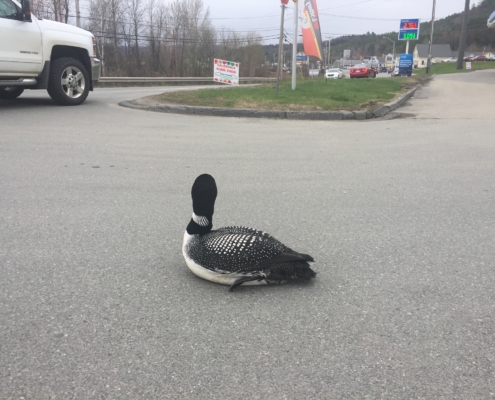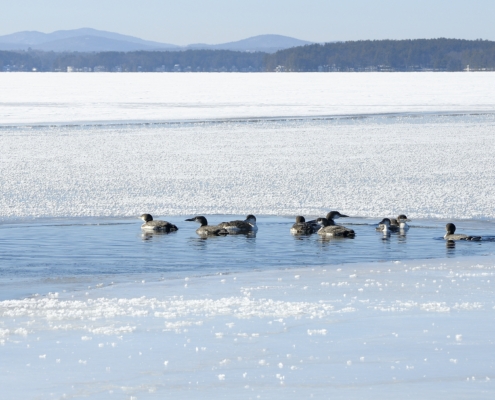Recognizing Loons in Distress
A number of things can cause loons to be in need of a rescue. Below, we have described several of the most common scenarios that indicate that a loon is in distress and in need of help. If you see a loon in distress in New Hampshire, please report it to the Loon Preservation Committee. Please do not try to rescue the loon yourself—loons are large animals with sharp bills, and they can be difficult and dangerous to handle. Those who are not trained to handle them risk injuring themselves or the loon.
Beached Loons
Loons are built for swimming and diving, with legs placed so far back on their bodies that they cannot walk well on land. Healthy loons spend the majority of their time in the water, only coming up on land to nest. If a loon is on land and not on a nest, that is a telltale sign that it is in trouble. Illness, injury, and lead poisoning are all ailments that cause loons to beach themselves. A beached loon may not have enough energy to keep itself afloat or may be on shore in order to reserve its energy to allow itself to heal. If you see a loon on land that is not on a nest, that loon is in distress and should be reported immediately.
Tangled Loons
There are many ways that loons may come in contact with fishing line and become tangled, including: consuming a fish that has broken an angler’s line and is trailing that line; striking at an angler’s line after mistaking the glint of tackle or the motion of the line being reeled in for a fish; trying to catch a fish that is on an angler’s line; or encountering discarded line floating on the lake.
Because they use their bills to clean themselves, loons that encounter fishing line often end up with the line wrapped around their bills, and the more they try to free themselves, the more tangled they become. With line around their bills, it is difficult for loons to eat and keep themselves waterproofed.
If you see a tangled loon, please report it to the Loon Preservation Committee immediately. It is important to note that when reporting a tangled loon, we will ask you to confirm that you see line, as some of the loon’s normal behaviors (see the ‘Recognizing Loons Not in Distress’ section below) can make it seem like loons are tangled when they are not.
Stranded Loons
Loons can end up in strange places! When flying, loons may mistake wet pavement (roads or parking lots) for water and try to land there. Because loons cannot walk, landing in these places renders them stranded, and without intervention, they’re in trouble. If you see a loon in a place it shouldn’t be (anywhere away from water, including on a road or highway, in a field, in a parking lot, etc.), please report it immediately.
Iced-In Loons
Loons are heavy-bodied birds with wings that are short and narrow relative to their body size. As such, they have a high rate of wing loading (the amount of weight supported by each square inch of wing), and they must work hard to take flight. Loons require a long runway, generally at least 100 yards and sometimes up to a quarter of a mile, in order to take off. If they remain on lakes too long, they they can become trapped, unable to take off as the ice closes in around them. Loons at risk of becoming iced-in should be reported to the Loon Preservation Committee, though it is important to note that an ice rescue is not likely to be successful until the loon is confined to a small amount of open water (generally a hole 15 feet or less in diameter).
Recognizing Loons that are NOT in Distress
As animals that are nearly always in the water, it is important for loons to perform actions that maintain the waterproofing and general condition of their feathers. If you’ve never seen them before, these behaviors can make it seem like the loon you’re watching is tangled or stuck on something. The videos and descriptions below can help you to determine whether the loon you are watching is in distress or performing a normal behavior.
Preening
Preening is a behavior that loons perform in order to keep their feathers waterproofed. Loons secrete oil from a gland at the base of their tails, and when preening, they use their bill to coat their feathers with this oil. They also rearrange feathers to create an interlocking structure, which prevents water from soaking through to their skin. Because preening loons appear to be picking at their bodies, they are often mistaken for being tangled.
A preening loon may: roll onto its back or side and use its bill to pull at its breast and belly feathers; stick one leg in the air and paddle in circles; rub its head against its back and shoulders to disperse oil; flap its wings hard and rise out of the water (appearing unable to take off); and shake its wings, head, and tail. While it may appear strange and alarming to us, loons that are preening are not in distress and do not need to be reported.
Video courtesy of John Rockwood.
Video courtesy of Alexis Rudko.
Bathing
Bathing allows loons to flush water between their feathers, washing away any accumulated dirt, debris, or parasites. When bathing, loons splash vigorously, submerge themselves in the water, and may scoot upside down across the surface of the water.
Bathing loons may also: completely roll over while thrashing in the water with partially open wings; flail one or both wings in the air; flail one or both legs in the air; slap or beat the water’s surface with their wings; dive backwards into the water; and submerge their heads underwater and thrash.
Bathing can appear alarming, but it is a normal behavior. Bathing loons are not in distress and do not need to be reported.
Reporting Loons in Distress
The Loon Preservation Committee rescues loons that are in distress in New Hampshire. You can report loons in distress to us by using our online reporting form or by phone at (603)476-5666. Please note that in order to report by phone, you must call during our business hours. Reports may be submitted using our online reporting form at any time.
Please include the following key pieces of information in your report:
1) The location of the loon—please be as specific as possible. If the loon is on land, please provide the nearest house number or another landmark that will help us locate it. If the loon is in the water, please provide landmarks such as the name of a cove or island that it is in or near.
2) The loon’s behavior: what is the loon doing? What is making you think that it is in distress?
3) For tangled loons: Do you see fishing line on the loon? If so, is the line wrapped around the loon’s bill, or is it on another part of the loon’s body? Does the loon seem to be able to dive?
4) A picture (or video) is worth a thousand words! When possible, please include a photo or video of the loon in your report. This helps us to better evaluate the situation and develop a rescue plan.





